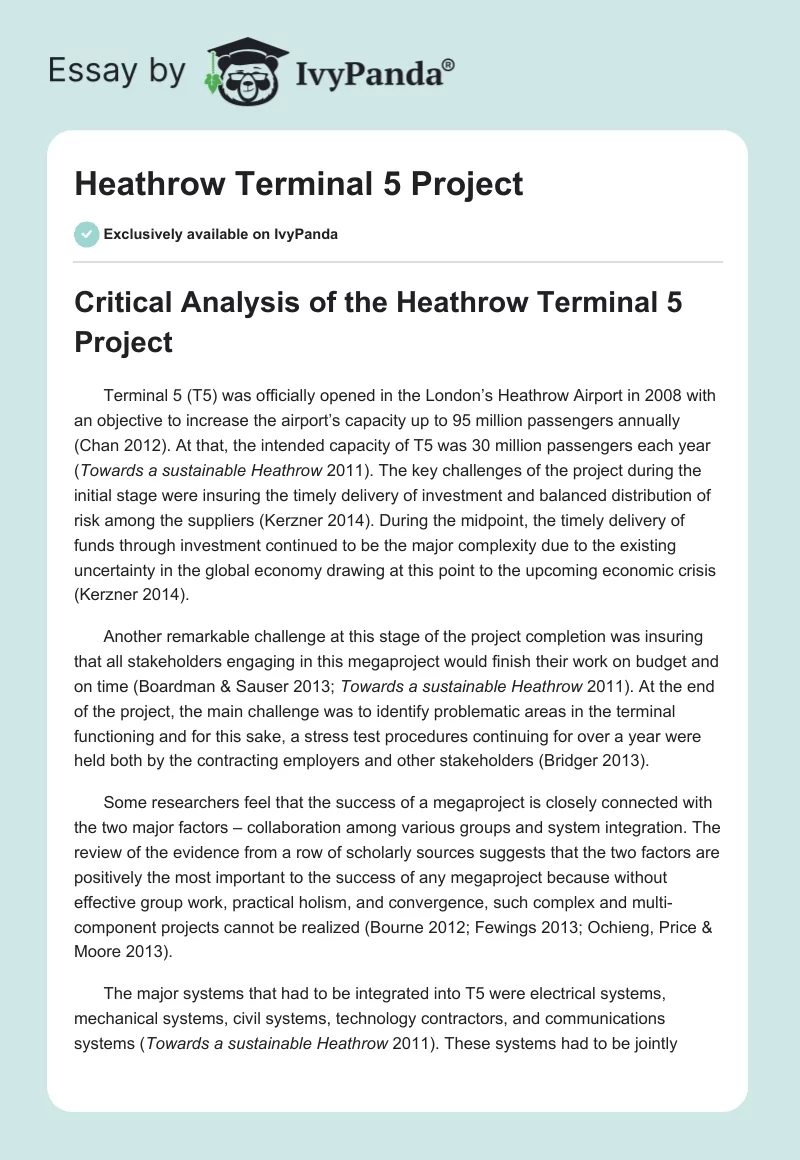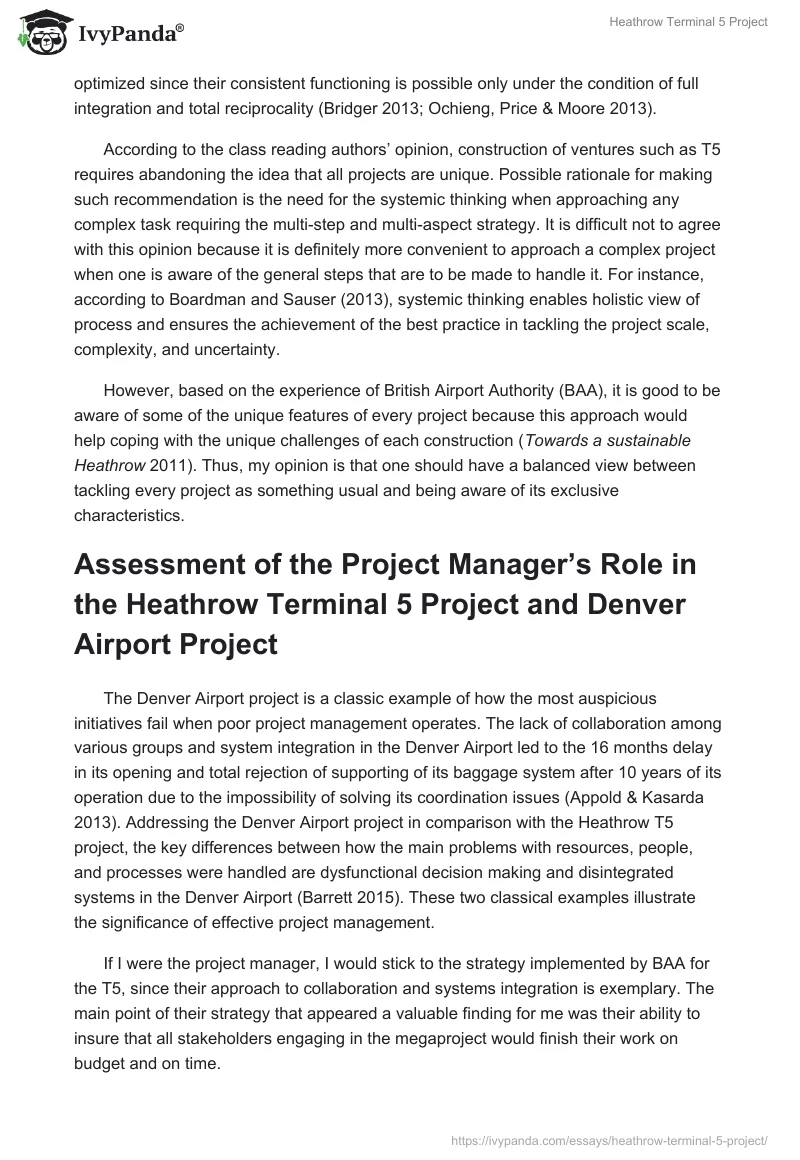Critical Analysis of the Heathrow Terminal 5 Project
Terminal 5 (T5) was officially opened in the London’s Heathrow Airport in 2008 with an objective to increase the airport’s capacity up to 95 million passengers annually (Chan 2012). At that, the intended capacity of T5 was 30 million passengers each year (Towards a sustainable Heathrow 2011). The key challenges of the project during the initial stage were insuring the timely delivery of investment and balanced distribution of risk among the suppliers (Kerzner 2014). During the midpoint, the timely delivery of funds through investment continued to be the major complexity due to the existing uncertainty in the global economy drawing at this point to the upcoming economic crisis (Kerzner 2014).
Another remarkable challenge at this stage of the project completion was insuring that all stakeholders engaging in this megaproject would finish their work on budget and on time (Boardman & Sauser 2013; Towards a sustainable Heathrow 2011). At the end of the project, the main challenge was to identify problematic areas in the terminal functioning and for this sake, a stress test procedures continuing for over a year were held both by the contracting employers and other stakeholders (Bridger 2013).
Some researchers feel that the success of a megaproject is closely connected with the two major factors – collaboration among various groups and system integration. The review of the evidence from a row of scholarly sources suggests that the two factors are positively the most important to the success of any megaproject because without effective group work, practical holism, and convergence, such complex and multi-component projects cannot be realized (Bourne 2012; Fewings 2013; Ochieng, Price & Moore 2013).
The major systems that had to be integrated into T5 were electrical systems, mechanical systems, civil systems, technology contractors, and communications systems (Towards a sustainable Heathrow 2011). These systems had to be jointly optimized since their consistent functioning is possible only under the condition of full integration and total reciprocality (Bridger 2013; Ochieng, Price & Moore 2013).
According to the class reading authors’ opinion, construction of ventures such as T5 requires abandoning the idea that all projects are unique. Possible rationale for making such recommendation is the need for the systemic thinking when approaching any complex task requiring the multi-step and multi-aspect strategy. It is difficult not to agree with this opinion because it is definitely more convenient to approach a complex project when one is aware of the general steps that are to be made to handle it. For instance, according to Boardman and Sauser (2013), systemic thinking enables holistic view of process and ensures the achievement of the best practice in tackling the project scale, complexity, and uncertainty.
However, based on the experience of British Airport Authority (BAA), it is good to be aware of some of the unique features of every project because this approach would help coping with the unique challenges of each construction (Towards a sustainable Heathrow 2011). Thus, my opinion is that one should have a balanced view between tackling every project as something usual and being aware of its exclusive characteristics.
Assessment of the Project Manager’s Role in the Heathrow Terminal 5 Project and Denver Airport Project
The Denver Airport project is a classic example of how the most auspicious initiatives fail when poor project management operates. The lack of collaboration among various groups and system integration in the Denver Airport led to the 16 months delay in its opening and total rejection of supporting of its baggage system after 10 years of its operation due to the impossibility of solving its coordination issues (Appold & Kasarda 2013). Addressing the Denver Airport project in comparison with the Heathrow T5 project, the key differences between how the main problems with resources, people, and processes were handled are dysfunctional decision making and disintegrated systems in the Denver Airport (Barrett 2015). These two classical examples illustrate the significance of effective project management.
If I were the project manager, I would stick to the strategy implemented by BAA for the T5, since their approach to collaboration and systems integration is exemplary. The main point of their strategy that appeared a valuable finding for me was their ability to insure that all stakeholders engaging in the megaproject would finish their work on budget and on time.
They managed to achieve this result by the well-thought of financial policy based on the principle of providing considerable bonuses for those stakeholders that would manage to complete work timely and in line with the agreed disbursements plan (Towards a sustainable Heathrow 2011). Since financial factor continues to be the major motivator for the stakeholder performance improvement, I would implement the approach of providing extra funding for the disciplined partners.
Reference List
Appold, S & Kasarda, J 2013, ‘The airport city phenomenon: evidence from large US airports’, Urban Studies, vol. 50, no. 3, pp.1239-1259.
Barrett, S 2015, ‘Ownership structures and the implications for developing airport solar projects in the USA’, Journal of Airport Management, vol. 9, no. 3, pp. 248-263.
Boardman, J, & Sauser, B 2013, Systemic thinking: building maps for worlds of systems, John Wiley & Sons, Somerset, NJ, USA.
Bourne, L 2012, Stakeholder relationship management, Gower, Farnham, GB.
Bridger, R 2013, Plane truth: aviation’s real impact on people and the environment, Pluto Press, London, GBR.
Chan, P 2012, ‘Heathrow’s Terminal 5: History in the Making’, Construction Management & Economics, 30, 6, pp. 498-500.
Fewings, P 2013, Construction Project Management, 2nd edn, Routledge, New Yourk, USA.
Kerzner, HR 2014, Project management – best practices: achieving global excellence, 3rd edn, John Wiley & Sons, Incorporated, Somerset, NJ, USA.
Ochieng, E, Price, A & Moore, D 2013, Management of global construction projects, Palgrave Macmillan, New York.
Towards a sustainable Heathrow 2011. Web.


